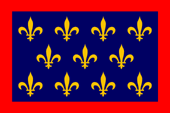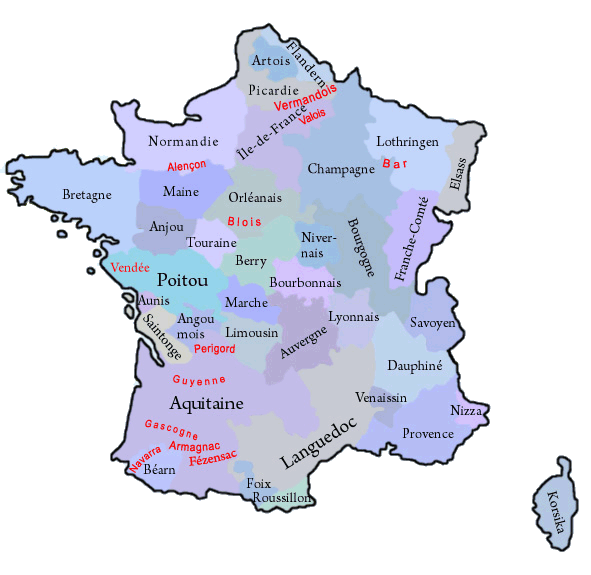mobile View, to the German Version tap the flag


- historical region in today's France
- former County of Valois
- part of the Île-de-France
• Flag
• Meaning/Origin of the Flag
• Coat of Arms
• Meaning/Origin of the Coat of Arms
• Map of the historical Regions in France
• Explanations about the Regions
• History
• Origin of the Country's Name

since 1285,
Flag of the County of Valois
– Drapeau de Comté de Valois,
Source, by: Wikipedia (D)




The flag of Valois is a scutcheon-flag, its design is the image of the coat of arms of the line of the Valois.
Source:
Volker Preuß


Coat of arms of Valois
– Armoriaux de Valois,
Source, by: Wikipedia (D)

The progenitor of the line of Valois, Prince Charles (1270–1325, son of King Philipp III.), Count of Valois, Anjou and Maine, took over the coat of arms from Prince John Tristan (1250–1270, Count of Valois, son of King Ludwig IX.). He surrounded the lily arms of the Capetians with a wide red border. The coat of arms of the Capetians showed three golden lilies on blue, but originally was the coat of arms sprinkled with lilies. From 1365 (by others sources 1376), the number of lilies was reduced to three. The lily-symbol is very old, already the Germanic tribe of the Franks has used it. The House of the Capetians has provided the kings of France between 987 and 1328. It goes back to Hugo Capet, son of Hugo the Great, who was electet to the King of France, in 987, after the death of King Ludwig V. from the House of the Carolingians. The Capetians brought out three branch lines which became the Kings of France: Valois 1328–1589, Bourbon 1589–1792 and 1814–1830, and Orléans 1830–1848.
Source:
Volker Preuß,
Wikipedia (D)

The historical, French Regions:

in black: governorate and province in 1776,
in red: former county, province oder governorate
Map: Volker Preuß

The until the French Revolution existing provinces (or governorates) have been historically grown structures, which had their roots oftenly in former fiefdoms of the French crown, historic counties and duchies. They oftenly existed for hundreds of years and had preserved regionality (e.g. cultural particularities and regional languages). On the occasion of the French Revolution such phenomena were of course not desirable, and as part of their bloody and violent egalitarianism any regional references were eliminated. Shortly after the French Revolution the provinces were dissolved and France became divided into many départements, which should have approximately the same size and the same status. The départements were named after rivers or mountains, to use never and in no circumstances the name of an old province. However, there was no success in cutting the connections of the people of France to their respective regions, so that administrative regions were re-created in 1960, to have a better control in regional administrative processes. In this way became départements, which were placed in a historical province, administratively grouped to an oftenly historically named region. The resulted structures coincide only approximately with the boundaries of the old provinces. In the strictly centralist France any regionality is avoided, so that even the official flags of these regions mostly look like flags of companies, unloving, unhistorical, technocratic and modernistic, and these flags should not be a subject of any lexical considerations here. Only in a few of that regions, exist official flags which remember the historical models. But, even the existence of these today's regions is douptful, because in 2014 was passed a territorial reform valid from the year 2016, that reduces the number of the existing regions by merging to nearly the half. However, there exist unofficial flags in nearly all of these regions, which should remember the old provinces and the old heraldry.
Wikipedia Link to the regions of France:
click or tap here
FOTW Link to the regions of France:
click or tap here
Source: Flags of the World,
Wikipedia (D),
Volker Preuß

9th century · probably the time of the establish of the County of Crépy (named after the main town), but its official name was "Pagus Vadensis", changed over time to "Valois"
1077 · extinction of the Counts of Valois , the county is inherited as a legacy to the Counts of Vermandois, a branch line of the Carolingians, from which it later came as legacy to the House of Capet (Capetians, Kings of France, 987–1328)
1285 · Prince Charles receives from his father, King Philip III . (the Brave, from the House of Capet) the County of Valois
1328 · death of King Charles IV. (the Fair), extinction of the direct Capetian line, according to Salic Law Count Philip of Valois (Son of Prince Charles of Valois, first cousin of King Charles IV.) came on the French throne (as King Philip VI .), the English king Edward III. lays claim to the throne as a maternal nephew of Charles IV., reason for the "Hundred Years War" (Anglo-French War), out of the House of Valois came all kings of France from 1328 to 1589
1500 · King Louis XII . (1498–1515) raises the Valois to a Duchy
16th century · King Francis I. (1515–1547) affiliates the Valois to the royal domain
Source:
1.) Wikipedia (D),
2.) Wikipedia (D)

The name "Valois" goes back to the original name of the County of Crépy: "Pagus Vadensis". This latin name was changed over the years, and was shortened to "Valois".
Source: Wikipedia (D)


![]()





